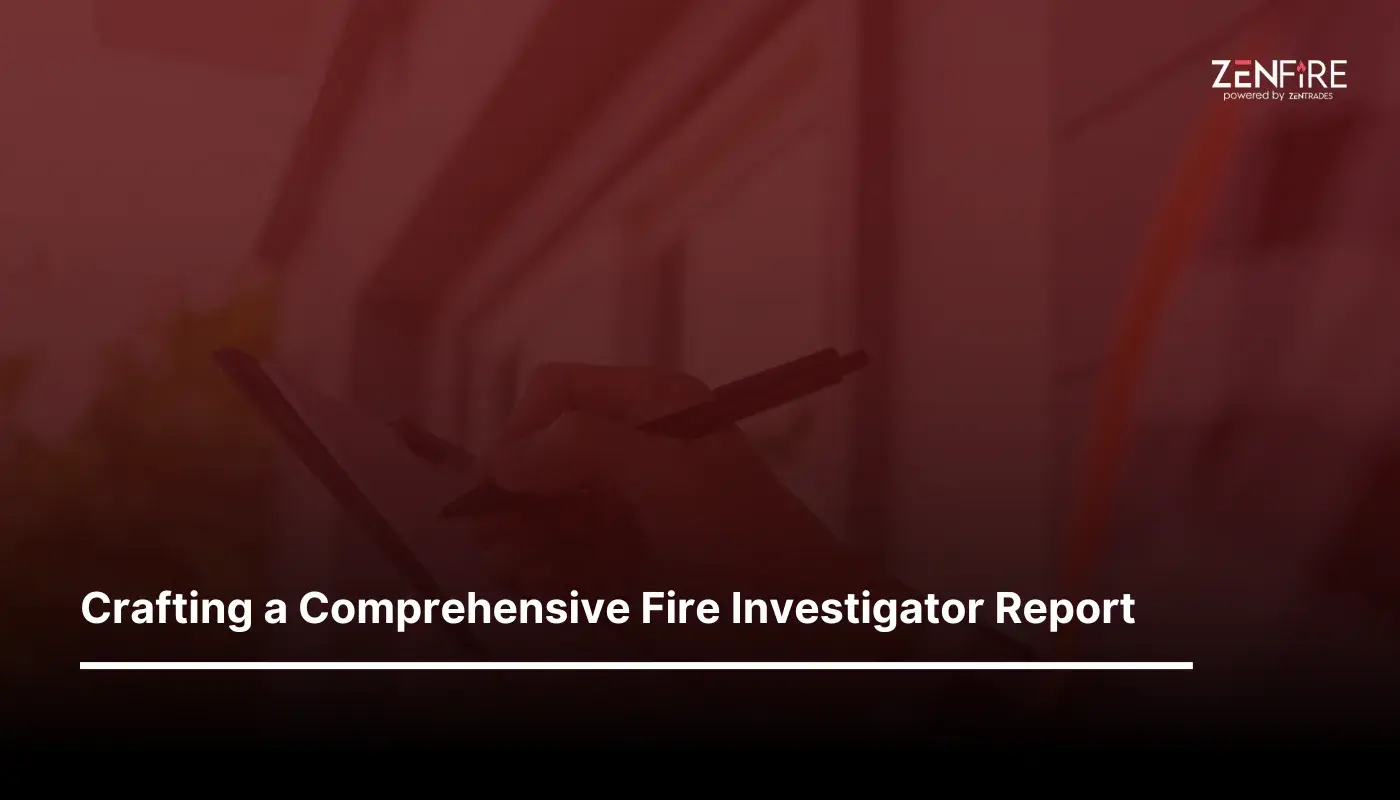Crafting a Comprehensive Fire Investigator Report
- ZenFire
- 9 Min Read
Fire reports are an essential component that helps you assess the nitty-gritty of a fire scene investigation. Fire incidents don’t come announced. With adequate prevention and protection strategies, you also need to ensure proper documentation of the same.
For instance, reports by NFPA on Fatal Firefighter Injuries in the US will provide statistical data to help you assess emergency responders’ death and injury rates while trying to mitigate a fire scene. This report is helpful for researchers and fire policymakers to understand the circumstances and causes of fatality for firefighters, which can be used to enhance safety training programs and implement better risk management strategies to safeguard their emergency responder personnel.
The data from the above report is also helpful for updating safety protocols and policies to prevent future injuries and deaths. Other types of fire reports, such as fire incident reports, also come in handy and are created considering the observations and circumstantial information gathered from the fire scene investigation.
Even though fire incident reports provide us with an overview of the fire scene investigation, a fire investigator’s report gives us an in-depth glimpse into the detailed version of the same, and you should also know how to analyze fire department reports.. These reports are extremely helpful for various reasons. They showcase a detailed examination of the fire scene and analysis of burn patterns, fire protection units, the origin and cause of the fire, and other evidential information. These factors help fire investigators explore the root cause and origin of the accident—whether it was unintentional or an arson case.
This blog will help you understand what goes behind creating fire investigation reports and how emergency responders can avoid complex challenges with some recommended best practices.
Here What We Cover
Pre Fire Scene Investigation Preparation
Before the investigation begins, a thorough assessment of the residential fire scene is imperative as the chances of hazardous risks present are higher. These include structural damage, unsafe debris, exposed electrical wiring or heating equipment, gas leaks, etc. No fire investigator should enter or inspect the scene unless a thorough risk assessment has been taken.
Some basic safety precautions and preparations to be taken before the investigation process begins:
Conduct a risk assessment of the property or the residence before the investigation begins
Switch off the gas and electricity supply to avoid unnecessary dangers.
The property should be declared safe by the fire department before the investigator proceeds with the actual investigation.
Individuals and emergency responders entering the fire scene should be equipped with protective clothes such as coveralls, gloves, and face masks.
After ensuring the scene’s safety, the next step is conducting a thorough fire investigation.

Use our free estimate template now
Make winning quotes in minutes—for any industry and any job.
Conducting A Fire Investigation
Once all the mandatory precautions have been ticked off the list, it’s time to proceed with the fire investigation.
Examining Fire Scene: Gathering Evidence
Conducting a fire scene investigation involves a thorough external pre-check of the structure. This is to familiarize oneself with any structural defects present or to locate any signs of forced entry that could provide essential insights into the cause and origin of the fire.
The fire investigator identifies entry points and evaluates materials of property components such as the roof, chimney, vents, gutter, walls, and windows. This also contributes to valuable insights into the fire’s origin and cause.
A thorough checking of the fire alarm system and protection units is also essential to understand the scope of the fire, the units triggered, and the timestamps to understand the effectiveness of the units and identify any potential failures or defects that might have contributed to the spread of fire.
Additionally, the entire area should be scanned meticulously in case any flammable substance is found. The presence of tools and ladders used for breaking into the home provides concrete fire scene evidence that can help investigate the case in the right direction.
Findings And Witness Interviews
The fire investigation unit also collects witness findings and statements to support its examination of the property fire. These valuable insights can help the case and enable quick conclusions to generate the reports accurately and quickly.
Witness interviews aid in faster procedures as their statements provide raw insights into the incident, such as the first glimpse of fire, the number of individuals present, the possible cause of the fire, any odor emitted, and other various conditions that led up to the fire’s events.
Gathering witness statements from individuals refers not only to neighbors and pedestrians but also to firefighters and police officers. You can gather vital information from their initial visual assessment of the situation at their specific arrival time and how disastrous the condition was. You never know when a neighbor or a passerby has taken a snapshot of the scenario, which can prove useful in the long run as investigative evidence.
Fire Scene Documentation And Evidence Collection
Documenting and collecting multimedia evidence at the fire scene is vital for establishing credibility in the investigator’s observations. Two kinds of visual documentation are preferred to facilitate a fire investigation report: photos and videos. A detailed floor plan can also be useful in certain situations, such as in arson cases, where the plan can provide proper evidence.
Collecting visual evidence begins with taking photographic and video notes of the property’s external structure. This evidence aids in a smoother insurance claim procedure and is vital for court proceedings if the case turns out to be arson.
What Is A Floor Plan?
A fire scene floor plan is a detailed, structured diagram of the property that provides a reference in a fire situation. It helps them analyze the area and derive meaningful conclusions that will help them better understand the case.
Compiling Fire Investigator Report
Taking safety precautions, interviewing witnesses, examining the scene, and gathering visual documentation – after all the necessary procedures have been done, it is time to compile all the data and create the fire investigator report.
To craft a comprehensive investigation report, you need previously collected information, such as witness statements, multimedia evidence, a fire scene floor plan, and other findings that will help you make a better report on the fire incident scene.
The document should also include information such as the fire department units that responded, the time of the call, personnel identification numbers, the type of call, and a brief description of the work done and the disposition.
Get posts like this in your inbox.
Keep learning how to run a 5-star business with our bi-weekly newsletter.
Challenges And Best Practices
Fire investigators and other emergency responders faced many complications and chaos in the field where the fire occurred. These can hinder their work or make it difficult for them to fulfill their duties properly. Hence, certain best practices should be followed and maintained onsite to tackle common challenges that emergency responders face.
Prioritizing safety and take necessary precautions when investigating a fire scene.
Conducting thorough and systematic investigations, gathering all relevant evidence and documentation.
Ensuring reports are accurate, objective, and comply with legal and professional standards.
Staying up-to-date with the latest techniques, technologies, and best practices in fire investigation and reporting.
Conclusion
Crafting a comprehensive fire investigator report is crucial for understanding the intricate details of a fire incident. Fire reports serve as invaluable tools in assessing and mitigating the aftereffects of unexpected fire events. Whether it’s understanding the statistical data from reports like NFPA’s Fatal Firefighter Injuries or conducting meticulous on-site investigations, these reports provide critical insights for researchers, policymakers, and emergency responders alike. By adhering to best practices and prioritizing safety throughout the investigative process, fire investigators ensure thorough documentation and analysis, ultimately contributing to enhanced fire safety protocols and prevention strategies.

Explore a better way to grow your business. Book a free demo now!
Get organized, win jobs, and wow customers.
Book A Free Demo with ZenTrades Today!
Related Reading
Why Your Field Software Management Software Needs QuickBooks Integration
ZenTrades Why Your Field Service Management Software Needs QuickBooks Integration Read More Request Demo...
Read MoreZenTrades How To Manage Electrical Service Agreements Like...
Read MoreZenTrades The Best 5 Jobber Alternatives In 2023...
Read More

